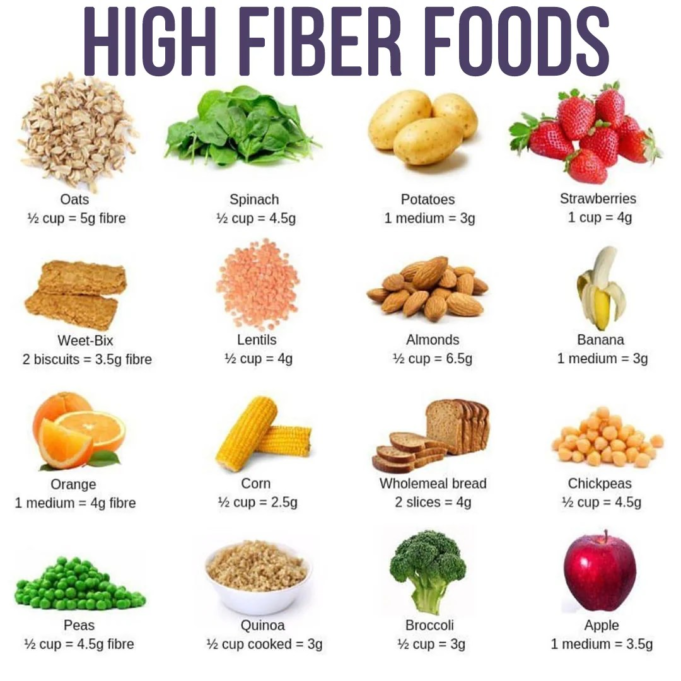How to get more fibre in your diet is a question many people ask, especially as they learn about its incredible benefits for digestion, overall health, and even weight management. Fibre, a type of carbohydrate our bodies can’t digest, acts like a natural broom, sweeping waste through our digestive system. This not only keeps things moving smoothly but also plays a vital role in regulating blood sugar levels, lowering cholesterol, and promoting a healthy gut microbiome.
In this comprehensive guide, we’ll explore the different types of fibre, their benefits, and how to incorporate them into your daily meals. We’ll also address common concerns about increasing fibre intake, including potential side effects and how to manage them. Get ready to discover the power of fibre and unlock a healthier, happier you!
Understanding Fibre
Fibre is a type of carbohydrate that our bodies cannot digest. It’s an essential part of a healthy diet and plays a crucial role in maintaining digestive health, regulating blood sugar levels, and promoting overall well-being.
Types of Fibre
There are two main types of fibre: soluble and insoluble.
- Soluble fibre dissolves in water and forms a gel-like substance in your gut. It helps to slow down digestion, which can help regulate blood sugar levels and lower cholesterol. Good sources of soluble fibre include oats, beans, lentils, apples, and citrus fruits.
- Insoluble fibre does not dissolve in water and adds bulk to your stool. This helps to prevent constipation and promote regular bowel movements. Good sources of insoluble fibre include whole grains, vegetables, and nuts.
Recommended Daily Intake of Fibre
The recommended daily intake of fibre for adults is 25-38 grams. However, most people do not consume enough fibre.
Potential Consequences of a Low-Fibre Diet, How to get more fibre in your diet
A low-fibre diet can lead to several health problems, including:
- Constipation: This is the most common consequence of a low-fibre diet. Fibre adds bulk to stool, making it easier to pass. Without enough fibre, stool can become hard and difficult to pass, leading to constipation.
- Diverticular disease: This is a condition that affects the large intestine. It can cause pain, bloating, and bleeding. A low-fibre diet is thought to increase the risk of diverticular disease.
- Heart disease: Soluble fibre can help lower cholesterol levels, which can reduce the risk of heart disease.
- Type 2 diabetes: Fibre can help regulate blood sugar levels, which can reduce the risk of type 2 diabetes.
- Colorectal cancer: Some studies suggest that a high-fibre diet may reduce the risk of colorectal cancer.
Incorporating Fibre into Your Diet
Now that you understand the importance of fibre, let’s explore how you can easily incorporate it into your daily meals. There are many delicious and nutritious ways to boost your fibre intake, and it’s easier than you might think!
High-Fibre Foods
To increase your fibre intake, focus on consuming a variety of foods rich in this essential nutrient. Here’s a breakdown of high-fibre foods across different food groups:
- Fruits: Berries (strawberries, raspberries, blueberries), pears, apples, bananas, oranges, avocados
- Vegetables: Broccoli, Brussels sprouts, carrots, spinach, peas, sweet potatoes, artichokes, asparagus, green beans
- Grains: Whole grain bread, brown rice, quinoa, oats, barley, popcorn
- Legumes: Lentils, beans (kidney, black, pinto), chickpeas
- Nuts and Seeds: Almonds, walnuts, chia seeds, flax seeds, pumpkin seeds, sunflower seeds
Sample Meal Plan
Here’s a sample meal plan that demonstrates how to incorporate fibre-rich foods throughout the day:
Breakfast: Oatmeal with berries and nuts
Lunch: Lentil soup with whole grain bread
Dinner: Salmon with roasted vegetables and brown rice
Snacks: Apple slices with almond butter, a handful of mixed nuts, or a small bowl of berries
Fibre Content of Bread, Pasta, and Rice
The following table compares the fibre content of different types of bread, pasta, and rice:
| Food | Fibre per serving (grams) |
|---|---|
| White bread | 1-2 |
| Whole wheat bread | 3-5 |
| White pasta | 2-3 |
| Whole wheat pasta | 6-8 |
| White rice | 0.5-1 |
| Brown rice | 2-3 |
Tips for Increasing Fibre Gradually: How To Get More Fibre In Your Diet
It’s crucial to increase your fibre intake gradually to avoid digestive discomfort. When you suddenly consume a lot of fibre, your body may struggle to adjust, leading to bloating, gas, and even constipation. The key is to introduce more fibre slowly and allow your digestive system to adapt.
Strategies for Gradual Fibre Increase
Here are some strategies to incorporate more fibre into your meals and snacks without drastically changing your eating habits:
- Start small: Instead of making major changes overnight, start by adding a small amount of fibre to your diet each day. For example, add a few tablespoons of bran flakes to your cereal or a handful of berries to your yogurt.
- Choose whole grains: Swap refined grains like white bread and pasta for whole grain options. Whole grains are a good source of fibre and other nutrients. Look for breads made with 100% whole wheat flour and brown rice instead of white rice.
- Include more fruits and vegetables: Fruits and vegetables are naturally high in fibre. Aim to eat at least five servings of fruits and vegetables daily. You can add them to your meals, snacks, or enjoy them as part of a healthy dessert.
- Add beans and lentils: Beans and lentils are excellent sources of both fibre and protein. Incorporate them into soups, stews, salads, or enjoy them as a side dish.
- Choose fibre-rich snacks: Opt for snacks like popcorn, nuts, seeds, and dried fruit. These options are a good source of fibre and can help keep you feeling full between meals.
Managing Potential Side Effects
While increasing fibre intake is beneficial, it’s important to be aware of potential side effects and how to manage them.
- Bloating and gas: Bloating and gas are common side effects of increasing fibre intake. To manage these symptoms, start with small amounts of fibre and gradually increase the amount over time. Drink plenty of water throughout the day, which helps to move fibre through your digestive system.
- Constipation: If you experience constipation, try increasing your fluid intake and engaging in regular physical activity. If these measures don’t help, talk to your doctor. They may recommend a stool softener or other medications.
Remember, everyone’s digestive system is different, so what works for one person may not work for another. Listen to your body and adjust your fibre intake as needed.
Fibre and Hydration
Increasing your fibre intake can be a positive step towards better digestive health, but it’s crucial to remember that fibre needs water to work effectively. Think of it like this: fibre acts like a sponge, absorbing water in your digestive system. Without enough water, the sponge becomes hard and dry, leading to discomfort and constipation.
Water’s Role in Digestion
Water plays a vital role in the digestive process, helping to soften stool and make it easier to pass. When you increase your fibre intake, your body needs more water to help the fibre move smoothly through your digestive system. Adequate hydration prevents constipation and promotes regularity, which is essential for overall gut health.
Daily Water Intake Recommendations
The amount of water you need each day depends on various factors, including your activity level, climate, and overall health. Here’s a general guideline for daily water intake:
- Women: 2.7 liters (91 ounces) per day
- Men: 3.7 liters (125 ounces) per day
These recommendations are based on the average person. If you engage in intense physical activity or live in a hot climate, you’ll need to drink even more water. Listen to your body and drink when you’re thirsty.
Fibre for Specific Health Conditions
Fibre plays a crucial role in managing various health conditions, contributing to better overall well-being. This section will explore the benefits of fibre for conditions such as diabetes, heart disease, and weight management, and provide dietary recommendations tailored for these specific needs.
Fibre and Diabetes
Fibre is a valuable tool in managing blood sugar levels for individuals with diabetes. It slows down the absorption of sugar into the bloodstream, helping to prevent sharp spikes and crashes in blood glucose. This can lead to improved blood sugar control and a reduced need for medication.
Here are some dietary recommendations for individuals with diabetes:
- Include a variety of high-fibre foods in your diet, such as whole grains, fruits, vegetables, legumes, and nuts.
- Aim for 25-35 grams of fibre per day, gradually increasing your intake as tolerated.
- Choose whole-grain bread, pasta, and cereals over refined options.
- Incorporate legumes like lentils, chickpeas, and beans into your meals.
- Snack on fruits and vegetables with the skin on, as this provides more fibre.
Fibre and Heart Health
Fibre can positively impact heart health by lowering cholesterol levels, particularly LDL (bad) cholesterol. It also helps regulate blood pressure and reduces the risk of heart disease.
Here are some dietary recommendations for individuals aiming to improve their heart health:
- Choose whole grains over refined grains to increase your fibre intake.
- Include fruits and vegetables in your diet, focusing on those rich in soluble fibre like oats, beans, and apples.
- Limit saturated and trans fats, and choose lean protein sources.
- Engage in regular physical activity, as this also contributes to heart health.
Fibre and Weight Management
Fibre can be a valuable tool in weight management. It helps you feel fuller for longer, reducing cravings and promoting a feeling of satiety. This can lead to reduced calorie intake and ultimately contribute to weight loss or maintenance.
Here are some dietary recommendations for individuals aiming to manage their weight:
- Prioritize high-fibre foods like fruits, vegetables, whole grains, and legumes.
- Choose low-calorie, high-fibre snacks like air-popped popcorn or a handful of almonds.
- Increase your water intake to help you feel fuller and support digestion.
- Combine fibre-rich foods with lean protein sources and healthy fats to create satisfying meals.
Fibre and Gut Health
Fibre acts as a prebiotic, nourishing the beneficial bacteria in your gut. These bacteria play a crucial role in digestion, immune function, and overall gut health. A balanced gut microbiome is associated with improved digestion, reduced inflammation, and a stronger immune system.
Here are some tips for promoting gut health through fibre intake:
- Consume a diverse range of fibre-rich foods to provide a variety of nutrients for your gut bacteria.
- Gradually increase your fibre intake to allow your gut to adjust.
- Stay hydrated by drinking plenty of water to support digestion and prevent constipation.
- Consider taking a probiotic supplement to further support your gut microbiome.
Last Recap

By understanding the importance of fibre, incorporating it into your diet, and staying hydrated, you can enjoy the many benefits it offers. From improved digestion and weight management to a reduced risk of chronic diseases, a high-fibre diet is a cornerstone of a healthy lifestyle. Remember, a gradual approach is key, and listening to your body is essential. So, embrace the power of fibre and experience the difference it can make in your overall well-being!
FAQ Section
What are the best sources of soluble fibre?
Soluble fibre dissolves in water and forms a gel-like substance in your gut. Good sources include oats, beans, lentils, apples, and pears.
Can I get too much fibre?
While getting enough fibre is essential, consuming too much too quickly can lead to digestive discomfort. Start slowly and increase your intake gradually to give your body time to adjust.
What if I experience bloating or gas when increasing fibre?
These are common side effects, especially when you first start increasing fibre. Drink plenty of water, eat fibre-rich foods with meals, and gradually increase your intake. If symptoms persist, consult a healthcare professional.
Is it safe to increase fibre if I have a medical condition?
It’s essential to talk to your doctor before making significant dietary changes, especially if you have a pre-existing medical condition. They can advise on the appropriate fibre intake for your specific needs.
Adding more fibre to your diet can be as simple as making smart choices at lunchtime. For some inspiration, check out these ideas for diet lunch that are packed with fibre-rich ingredients. From lentil salads to whole-grain wraps, you can easily boost your fibre intake while enjoying a satisfying and healthy meal.
Increasing your fiber intake is a great way to feel fuller for longer and aid in weight management. There are many ways to do this, from incorporating more fruits and vegetables into your meals to choosing whole-grain options. You might also want to consider exploring different types of diets to lose weight that emphasize fiber-rich foods, such as the Mediterranean diet or a plant-based approach.
Regardless of the path you choose, remember that a balanced and varied diet is key to maintaining good health and achieving your weight goals.
Increasing your fiber intake is essential for digestive health and overall well-being. You can easily boost your fiber by incorporating more fruits, vegetables, and whole grains into your diet. While on a ketogenic diet, you may wonder if diet soda is permissible, and you can find out more about that by checking out this article: can you drink diet soda on keto.
Remember, regardless of your dietary choices, staying hydrated and consuming adequate fiber are crucial for maintaining a healthy body.
























